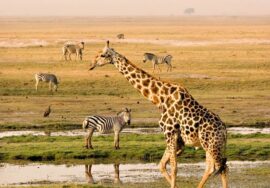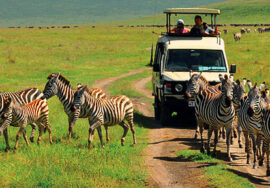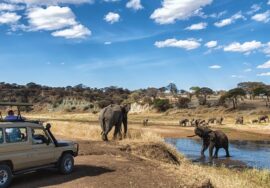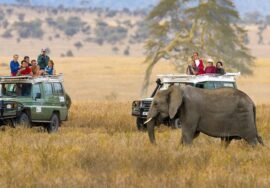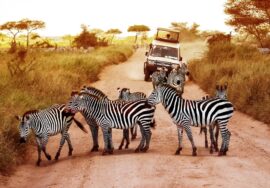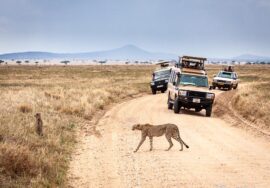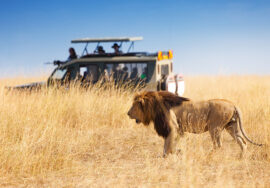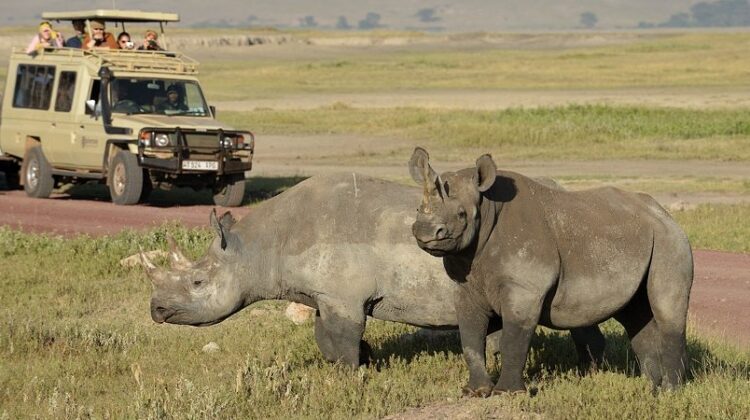
6-DAY FOUR-PARK “ALL-IN” TANZANIA SAFARI
What’s the best thing about this safari tour that costs nothing? You won’t have to pick which of our exciting Tanzania parks to see; you’ll see them all!
Everyone has heard of the Serengeti, which has endless fields and a huge number of animals. The sheer number of wildebeests crossing the grassland in Serengeti will amaze you. Not many parks can say that their animal populations number in the millions.
There is a lot of wildlife in the Ngorongoro Conservation Area, and going into the world’s biggest intact volcanic caldera is a magical experience which makes the whole place look amazing. You are now in a new world of experiences that is cut off from the rest of Africa.
Lake Manyara National Park is not what you would think. Picture a cobalt blue lake surrounded by huge flocks of bright pink flamingos. Add to that a lush, green blanket of an acacia forest where monkeys, baboons, zebras, and elands live. Is there anything else? Yes, cats that climb trees!
Finally, our journey in Africa brings us to Tarangire National Park, which is home to more than 3,000 elephants and huge, strange baobab trees.
You can change Tarangire to Lake Eyasi if you’d like to. A number of bushman groups live in Eyasi and have done so for thousands of years. By coming here, you can see how people lived in a different time and place.
This big tour is a show of amazing landscapes, wildlife, and native cultures. We will do it all in six days full of exciting things to do. Read on to find out more about this full safari trip.
What’s Cool About These Parks?
Did we say that the cats at Lake Manyara can climb trees? People come to the park to see this strange subspecies, which hangs out on the branches of acacia trees. More than 400 kinds of birds nest in the woods and fill the sky with color in Manyara.
The Serengeti is huge, almost to the point of not having any limits. It has more than 3,000 lions, which is more than any other park in Africa. Here, the wildebeests, zebras, and gazelles make up the heart of the world’s biggest animal migration. They move in what seems like an endless line in search of water and taller plants. You can’t see a sight like this anywhere else.
Ngorongoro is also one of a kind because not many parks can compare to it. Think about this: it’s the world’s biggest intact volcanic crater, and over 25,000 animals live there, including flamingos and lions. There are so many animals that we’ll be able to see many of them as we explore its deepest reaches. Also, the views from the edge of the crater are some of the best in Africa, both at sunrise and sunset.
Tarangire Park is especially nice if you’d rather see elephants than people, since there are many more elephants than people in this reserve, which is sometimes missed. During the months of July through October, zebras, wildebeest, buffalo, giraffes, lions, and especially elephants come together in groups to live in the park. This is something that many people don’t know.
Know anyone who lives in the bush? Not many people have seen an old culture that hasn’t changed much over the last thousand years. At Lake Eyasi, you can. The Hadzabi bushmen have lived in this area for more than 10,000 years and are hunters and gatherers. They are friendly, and you are welcome to join them in their daily activities.
The Added
You can enjoy extras like traditional dances and music around the boma, a spa, a boutique, a massage, a swimming pool, a kids’ menu, same-day cleaning service, Wi-Fi, special diet menus, honeymoon suites, family cottages, and more, depending on the type of room you choose.
The Specifics
The person who leads you on safari is the most important person there. Our driver/guides at Safari Trips to Kenya are the nicest and most knowledgeable. They will show you around, feed you, and treat you like the important guest you are. That’s what we promise.
Your own private 4×4 Land Cruiser Jeep will take you on adventure in style to the parks. This is the best way to see Africa because the seats are higher and the vehicle has rugged all-wheel drive.
At AKS, we give you more—customization, freedom, and a lot of options. The cost of your trip covers meals, lodging, game drives, and entrance fees to the parks. Also, we always have safari hotels or tented camps that are cheap, comfortable, very comfortable, or very comfortable.
Safari Trips to Kenya wants to help you plan a unique trip for you, your family, and your friends. Please give us a call at
6-DAY FOUR-PARK “ALL-IN” TANZANIA SAFARI
Day 1: Arusha – Lake Manyara
7:30 am: Let’s start the safari! Your Safari Trips to Kenya driver/guide will pick you up in a private 4×4 Land Cruiser Jeep from your hotel, home, or another place you choose.
We’ll be going through Maasai land on our way to Lake Manyara Park, where we might see Maasai farmers taking care of their flocks.
At Lake Manyara, the cobalt-colored alkaline lake and the bright groups of feathered pink flamingos that crowd the shores will really show off their colors.
Wildlife like elephants, giraffes, impalas, wildebeests, and busy groups of baboons live in the park’s acacia forest, which is a deep shade of green.
The lions that climb trees, on the other hand, may be the park’s most famous draw. They might be taken a nap way up on the branches of acacia trees while they wait for their picture to be taken.
It will be fun to spend our first night on safari at our Lake Manyara safari lodge or tented camp.
Day 2: Lake Manyara – Serengeti
How do you make sure that your safari is both busy and fun? An early start. The cool air and the park’s first signs of life in the morning make this the best time to see the big cats.
After breakfast, we’ll go on a game drive and then head out to the Serengeti.
It will be a fun and beautiful trip. We’ll stop to enjoy the scenery and have a picnic lunch.
After that, we’ll see how big the Serengeti is, going all the way to the sky. It had a huge number of wildebeests, zebras, and maybe the biggest group of lions in all of Africa.
We will be able to go on as many game drives as we want to see the Serengeti’s many wonders and different kinds of animals, such as topi, hartebeest, and waterbuck.
The first of our two nights in the Serengeti will be spent at our tented camp or park lodge.
Day 3: Full Day at Serengeti
Late night or early morning is the best time to be. The trees and grass look beautiful in the soft sunlight.
We will be able to go on as many game drives as we want during this time. We will explore the Serengeti’s huge savannahs and look at the huge numbers of wildebeests, zebras, and big cats that live there.
If you come here in February or March, you will be amazed to see up to 500,000 wildebeests and zebras giving birth across the Serengeti’s vast plains.
A few months later, in July through October, the young calves and the adults of the herd are at the center of what is known as the “Great Migration.” This is when millions of herding grazers move in long lines across the fields and into the Masai Mara in search of food.
We will also check out other parts of the park while we are here, like the forest and the marshes, to see if we can find hippos and crocodiles.
Our second night in the Serengeti will be spent at our safari lodge or tented camp.
Day 4: Serengeti – Ngorongoro
We got up early again because we have a lot to do today. We are going to the Ngorongoro Conservation Area.
After breakfast, we’ll leave in our own private 4×4 Jeep. But on the way, we’ll stop at the famous Olduvai Gorge, which is thought to be the world’s most important historical site. Here, the earth has opened up to reveal a treasure trove of fossilized tools and objects from early humans, a true record of our evolution over time.
As we continue our journey, we will reach the edge of the Ngorongoro Crater, a huge volcanic crater that is cut off from the rest of Africa and covers 263 square kilometers (101 square miles). The world’s biggest complete crater is its own world, with grasslands, swamps, and forests that are home to tens of thousands of animals.
Our 4×4 Jeep will carefully make its way down the steep crater wall that leads to this beautiful environment.
This remote area is home to all kinds of animals, including lions, leopards, buffalo, black rhinos, zebras, antelope, and birds like pink flamingos.
We’ll eat lunch here and be amazed by the variety of wildlife that has gathered in this one-of-a-kind spot.
Then, when late afternoon comes around, we’ll go back up the crater wall to see a famous Ngorongoro sunset, which is another gift from Africa.
In the evening, we’ll take it easy at our Ngorongoro lodging.
Day 5: Ngorongoro – Tarangire (3 Hour Drive) OR Ngorongoro – Lake Eyasi (2 Hour Drive)
Ngorongoro – Tarangire
You’ve been on safari before, so you know what to do: get up early to enjoy the peace and quiet of the morning. In fact, if we get up early enough, we can watch the sunrise from the edge of the crater.
We’re now going to Tarangire National Park, an area that doesn’t get many visitors. There are more elephants than people on safari, which makes it even more fun.
Of course, we’ll also look at the park’s strange baobab trees. With their big trunks and short branches, they look like they were put backwards!
This out of the way park has its own migration of over 250,000 animals that move through its fields and woods. These animals include buffalo, zebras, antelope, big cats, and more.
At our Tarangire safari lodge or tented camp, we’ll take it easy, eat dinner, and share tales of our travels on this last night of our safari.
Ngorongoro – Lake Eyasi
Let’s get ready for a very strange day.The Hadzabe live in Lake Eyasi. They are one of the last hunter-gatherer groups in Africa. This trip is like going back in time.
We’re going to spend the night here and get a better look at how these old people hunt and gather fruit. We’ll also learn about their daily lives and traditions. In fact, you can join them as they do their things and enjoy their traditional dances.
Day 6: Tarangire – Arusha
On our last day of adventure, let’s get up early to enjoy the quiet of this unique park. You’ll get one last chance to see the big cats, zebras, rhinos, and, of course, elephants on our morning game drive.
We will soon start our trip back to Arusha. In the afternoon, we’ll take you back to your home, hotel, the airport, or any other place you choose.
We could also go back to Arusha from Lake Eyasi.
There were hundreds or even thousands of our beloved wild animals in those six days and four parks. We hope that the pictures, thoughts, and feelings we shared with you about our amazing nature world will stay with you forever. Thank you from everyone at Safari Trips to Kenya for taking the time to read this and for being interested in our unique way of life.

